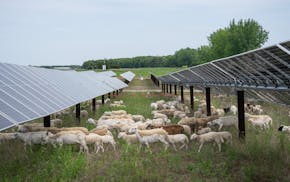Minnesota's earliest hunting seasons open on a Sunday this year, and the state's annual harvest of wild game will be subject to an assortment of new regulations.
Spelled out by the Department of Natural Resources in the hunting and trapping rules handbook, here's a breakdown of notable changes.
On Sept. 1, bear season opens on the same day waterfowlers start bagging geese and blue- and green-winged teal. The early teal season is a five-day hunt that began in 2021 as an experiment to increase duck hunter numbers. The DNR has decided to keep it.
The early teal season ends Sept. 5, while the statewide early goose season runs Sept. 1-15. For that, hunters no longer need a special permit to take Canada geese. Once again, early-season waterfowlers are urged to watch out for the safety of wild-rice gatherers and heed local rules on tribal and federal lands.
As an example, the U.S. Fish and Wildlife Service announced an emergency closure of Area C Hunt Unit at Tamarac National Wildlife Refuge north of Becker County. The closure is for the duration of the early teal season on rice-bearing waters.
Archery hunting of deer opens Sept. 14, running until the end of the year. New in 2024 is the expansion of archery deer hunting at Camp Ripley, the 53,000-acre Minnesota National Guard training grounds near Little Falls. Formerly open to archery hunters on a limited basis, Camp Ripley this year will host up to 150 archery hunters a day starting Sept. 14 through Dec. 31. Permits are available electronically. Camp Ripley is administering the hunt.
New this year to all Minnesotans who hunt deer, elk and moose, the Legislature loosened the carcass importation ban by allowing hunters to bring into the state whole heads of those three animals. But to qualify for the exclusion, the hunters must take their specimens to a licensed taxidermist within 48 hours of entering the state. Participating taxidermists will be required to use an approved landfill for biological waste, reducing the risk of spreading wildlife illnesses like chronic wasting disease (CWD).
The new program also applies to hunters who harvest a deer within Minnesota's CWD management zones. They will be allowed to deliver a deer head with or without the hide and neck to a taxidermist within 48 hours of leaving the management zone. Otherwise, no part of a deer carcass can be removed from a CWD management zone until tissue testing is completed.
Various CWD management zones — where tissue sampling is mandatory on the opening weekend of the firearms season — are eliminated or added each year. Eliminated this year are Deer Permit Areas 233, 255, 293 and 341 in southeast Minnesota. In the same region, the DNR has created a new CWD management zone in Wabasha County. It was added because of a positive CWD detection in a whitetail during last year's hunting season.
In the northern portion of the state, the DNR has imposed lower bag limits in 30 deer permit areas to reduce the harvest of antlerless deer. The intent is to increase deer populations hit hard by severe winters in 2021-2022 and 2022-2023.
Public lands hunters are being reminded by the DNR that they are required this season to adorn any ground blinds with a 12-by-12-inch square of blaze orange. The rule applies during archery, muzzleloader and firearms seasons. The orange squares aren't required for hunting blinds deployed on private land.
Trappers also face rule changes. Jason Abraham of the DNR said the season for taking otters will lengthen into May. In the past, otters could be trapped from late October until mid-January. Incidental catches after that period would have to be turned over to a local conservation officer, to be used for training and education.
Abraham said extending the season to coincide with the end of beaver trapping shouldn't result in a meaningful increase in otter mortality. "Otter populations have been very, very strong and widely dispersed," Abraham said. "It's a very sustainable change."
Also new this year is a trapper apprentice validation for children who want to try trapping without completing the certification process. The validation costs $2.50.
"It's another way to get kids out into the field," Abraham said. "If they enjoy it, then they can actually go through the [certification] class." A trapper's license is needed at age 13.
Abraham said the DNR is on track to enter the era of electronic, paperless licensing in March. The new system is pending while in the hands of the DNR, Minnesota IT Services and PayIt, an external vendor with systems operating in other states.
Until paper licenses run out, it's legal for hunters and anglers in Minnesota to make digital images of those licenses to show a conservation officer.

Xcel lets loose a small army of hungry sheep to keep its solar farm in order

Anderson: In early June, Minnesota fish are begging to be caught. Won't you help?

So you want to get an e-bike? Here's what you should know in Minnesota
Baby opossums are emerging from their mothers' pouches

